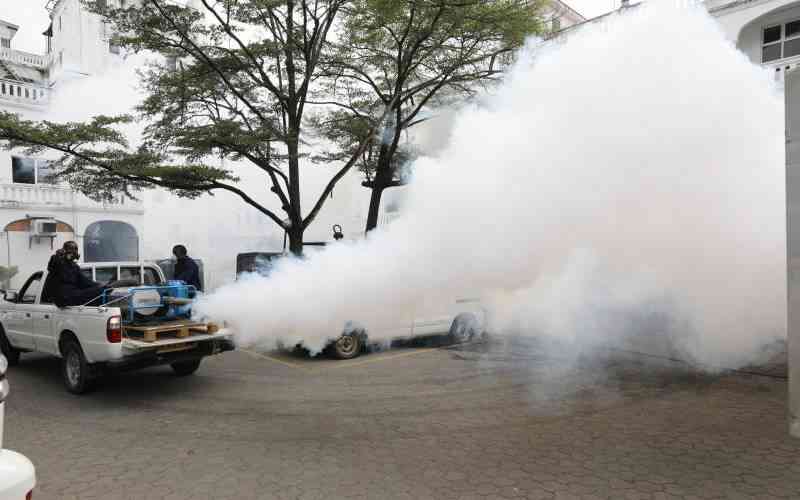Mombasa Confirms 25 Cases of Chikungunya Outbreak

Mombasa County is currently experiencing a Chikungunya outbreak, with health officials confirming at least 25 positive cases after laboratory analysis at the Kenya Medical Research Institute (KEMRI). The mosquito-borne virus has resurfaced due to ongoing rains, which have created widespread breeding grounds for mosquitoes, thereby exacerbating the situation. Out of 50 suspected cases, 45 samples were tested, revealing one case of dengue fever alongside the 25 Chikungunya infections, according to the Ministry of Health. The most affected sub-counties include Mvita, Kisauni, Nyali, and Likoni.
In response to the outbreak, county officials have activated emergency response teams and initiated fumigation exercises in the hardest-hit areas. Residents are strongly urged to take preventive measures by eliminating potential mosquito breeding sites, ensuring water storage containers are securely covered, and consistently using mosquito nets to curb further spread of the virus.
Dr. Saumu Wayua, Acting Director of Public Health and Disease Prevention, highlighted the distinct nature of Chikungunya, stating, “We’ve had malaria and dengue fever before, but Chikungunya presents with more severe joint pain and swelling, often accompanied by a rash. It wasn’t as prevalent last year, but the ongoing rains have led to a sharp increase in cases. That’s why we had to conduct DNA PCR testing at KEMRI.”
This is not Kenya's first encounter with Chikungunya. In May 2016, the Ministry of Health reported an outbreak in Mandera East sub-county, where KEMRI confirmed 7 out of 10 samples tested positive for the virus. Subsequently, in December 2017, another outbreak affected all six sub-counties of Mombasa. By January 2018, the Ministry had recorded 69 suspected cases in Mombasa, with 27 confirmed. A 2021 study published in BMC Infectious Diseases further underscored the persistent presence of the virus in coastal Kenya and recommended including Chikungunya in the differential diagnosis for febrile illnesses, particularly in children.
Dr. Yubrine Moraa, a Consultant Physician and Cardiologist at Primecare Heart Clinic at The Nairobi Hospital, who has witnessed the virus's impact firsthand, emphasized that Chikungunya is primarily transmitted by Aedes aegypti and Aedes albopictus mosquitoes. These are aggressive daytime biters commonly found in urban environments. “Chikungunya has a rapid onset with intense joint pain, often described as ‘bone-breaking’,” Dr. Moraa explained. “Even after the fever subsides, joint pain can persist for weeks or even months.” According to the Centers for Disease Control and Prevention (CDC), typical symptoms include fever, joint pain, headache, muscle aches, joint swelling, and rash. Dr. Moraa also noted that lasting joint pain is a key indicator distinguishing it from flu or dengue.
Dr. Moraa warned that climate change is altering mosquito breeding patterns. “We’re seeing increased transmission even in previously low-risk areas due to poor drainage, urban sprawl, and rising temperatures,” she noted. She urged communities to recognize early signs of Chikungunya, which typically include sudden fever, rash, muscle pain, headache, and severe joint pain in areas like the hands, wrists, ankles, or feet.
Currently, there is no specific vaccine or antiviral treatment for Chikungunya. Care is mainly supportive. “Rest, fluids, and paracetamol are advised,” Dr. Moraa stated. “But NSAIDs or aspirin should be avoided during the acute phase, especially if dengue hasn’t been ruled out due to bleeding risks.” The virus, while generally self-limiting, can severely affect infants, the elderly, and individuals with chronic illnesses. Dr. Moraa added, “Urban hospitals are equipped to manage cases, but rural areas still face diagnostic and resource challenges during outbreaks.”
Prevention remains the most effective strategy. “While mosquito nets protect against malaria, repellents, screened housing, and eliminating standing water are essential for Chikungunya,” said Dr. Moraa. She called for robust community interventions, including cleanup campaigns, public awareness initiatives, and proper waste management to reduce mosquito populations. “Many people are aware of malaria but don’t understand the threat posed by Chikungunya, especially since these mosquitoes bite during the day. Public health messaging must evolve,” she stressed.
Dr. Moraa affirmed her commitment to public education and strengthening community preparedness. The World Health Organization (WHO) is currently reviewing global vaccine trial data to guide future recommendations for Chikungunya prevention. In the meantime, WHO advises that patients with suspected infections should avoid mosquito bites during the first week of illness to prevent spreading the virus to others.
As the rains continue, the threat of Chikungunya looms large over Mombasa and other vulnerable regions in Kenya. Coordinated local, national, and global efforts are urgently needed to curb its spread and protect communities.








